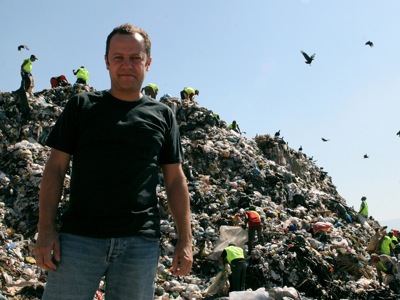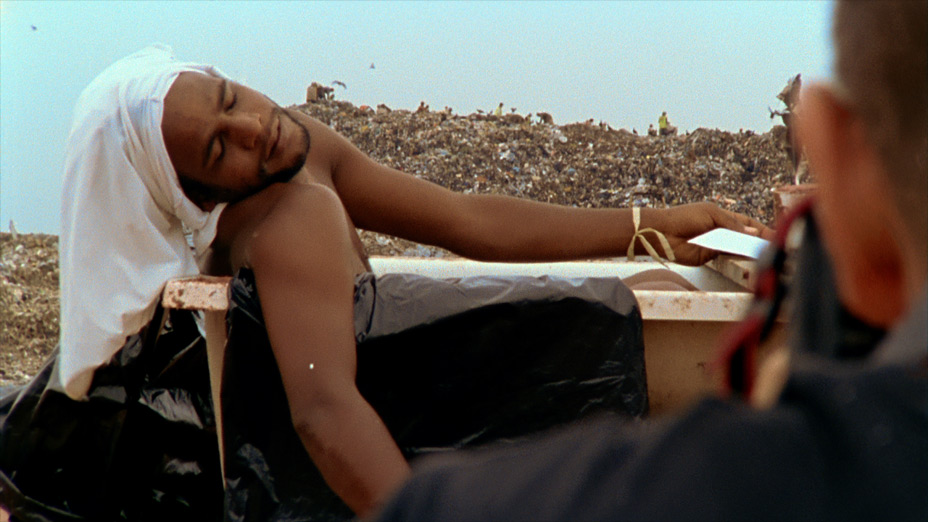|
The title of this documentary is derived from T. S.
Eliot's
apocalyptic poem The Waste Land,
where the world has been
polluted by modernity. Director Lucy Walker isn't as bleak about her
project
because the film has the framework of a simple feel good story. Yet
under the
surface is anger, hurt and true humanity. It was appreciated through
the eyes
of artist Vik Muniz who obtained a new perspective on the world. He's
extremely
wealth and popular but prior to this film he was unsatisfied with his
materialist
lifestyle. On the edge of Rio de Janeiro is Jardim Gramacho, the
world's
largest garbage dump. "Catadores" or pickers are people hired by the
ACAMJG (Association of Collectors of the Metropolitan Landfill of
Jardim
Gramacho) to organise the garbage there into recycles so the materials
can be
sold. Vik initially intended to paint the catadores with rubbish since
he is
adept in collecting everyday things for his projects. One of his most
famous
works is called "Sugar Children", where he used sugar from the
plantations in St. Kitts to develop images of the children working
there. The
purpose of this is to retain a tangible connection to his subjects as
he
constructs the works. It seems to remind him of what he is really
illustrating,
physically and metaphorically.

This same method surfaced during the Waste
Land project. He discovered that beneath the rubbish were
real people who suffered and sometimes didn't even know their own
situations.
Vik's wife commented that some of them are in denial and that taking
them out
of their environments would potentially disrupt their minds. It was a
valid
point because many of the people working on the landfill had been there
since
childhood. They scavenged through the enormous rubbish piles willingly
but were
smart enough to organise it into piles so it could be sold and recycled
efficiently. They showed their colour and intelligence to Vik through
some of
their quotes like '99 cans is not 100' and 'it's not rubbish because it
can be
recycled'. His empathy is clearly articulated in the documentary. He
said that
he used to grow up in poverty and suggested that he could have been
working in
the landfill. This is what developed his connection on camera and why
he chose
to make them the focus of the works. He auctioned off the paintings he
made of
them so that he could use the money to improve their lives. One of the
most humorous
paintings Vik design was a recreation of Jacques-Louis David's "The Death of Marat" in an old tub.

The class elements of Waste
Land are its most surprising socio-political concerns. Many of the
pickers
stated they were frowned upon by people, who were not only wealthy, but
well-educated Brazilians too. One of the common responses was that they
don't
care about being dirty because it was a more honest line of work than
the
prostitution in the area. The pickers in the film are distinguishing
because of
their courageous attitude but also because their stories are moving
too. One of
the women commented that she hated working in the landfill. She
described how
when her son died his body was wrapped in a plastic bag. Another woman
recalled
how she saw a baby left in the rubbish, which seemed deeply affecting
for her
because she had children of her own. The hurt beneath these people, who
were so
diligent towards a thankless task, gives the film emotional pull.
It
is a nice movie because it's about someone who simply wanted to
use his own wealth, status and creativity to do better by others. It's
very
cleanly photographed and one of the most interesting shots is a wide
angle of
Vik sitting in his quarters, surrounded by all the junk on his wall,
showing
his isolation. This is just after he said that he was unfulfilled by
how
materialistic his life became. The only thing wrong with the film is
that the Portuguese subtitles are in a white font, which means that in
bright
areas they are sometimes impossible to read. If it were a Hollywood
picture
people would call Waste Land sentimental
and predictable. Yet the importance of the documentary is that its
subjects and
their attitudes are real and that there are still genuinely kind and
hardworking people in the world. I find that alone extremely refreshing.
|